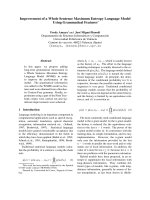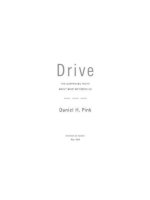Daniel h pink a whole new mind why right br ure
Bạn đang xem bản rút gọn của tài liệu. Xem và tải ngay bản đầy đủ của tài liệu tại đây (2.45 MB, 215 trang )
PRAISE FOR
A Whole New Mind
“This book is a miracle. On the one hand, it provides a completely original and profound analysis of the most pressing personal and
economic issue of the days ahead—how the gargantuan changes wrought by technology and globalization are going to impact the way
we live and work and imagine our world. Then, Dan Pink provides an equally original and profound and practical guidebook for survival
—and joy—in this topsy-turvy environment. I was moved and disturbed and exhilarated all at once. A few years ago, Peter Drucker
wondered whether the modern economy would ever find its Copernicus. With this remarkable book, we just may have discovered our
Copernicus for the brave new age that’s accelerating into being.”
—Tom Peters
“[Pink’s] ideas and approaches are wise, compassionate, and supportive of a variety of personal and professional endeavors. It’s a
pleasant and surprisingly entertaining little trip as he explores the workings of the brain, celebrates the proliferation and democratization
of Target’s designer products, and learns to draw and play games, all as a means of illustrating ways we can think and live in a better,
more meaningful and productive manner. What surprised me about this book is how Pink realized that to empower individuals, it’s
necessary to really understand and act upon the powerful socioeconomic forces that shape the world economy. Unlike many of the
recent xenophobic screeds that rail against the evils of outsourcing, Pink has figured out several paths that individuals and society can
pursue that play to our strengths. So if Pink is correct, we’re almost there. All it may take is for individuals and institutions to recognize
this reality by using the tools we already possess. And that may well require A Whole New Mind.”
—The Miami Herald.
“Since Pink’s . . . Free Agent Nation has become a cornerstone of employee-management relations,
expect just as much buzz around his latest theory.”
—Publishers Weekly
“A breezy, good-humored read . . . For those wishing to give their own creative muscles a workout, the book is full of exercises and
resources.”
—Harvard Business Review
“Former White House speechwriter Daniel H. Pink, an informed and insightful commentator on social, economic, and cultural trends, has
questioned the conventional wisdom from which most Americans draw their thinking on the way the world works. The author of this
well-researched and delightfully well-written treatise delivers that assertion after transporting the reader through a consciousnessawakening examination of how the information age, characterized predominantly by L-Directed (left brain) Thinking is being superseded
by an age of high concept and touch, which brings R-Directed (right brain) Thinking more into play. The L-Directed Thinking is
particularly in evidence in the guidance he provides to readers in what to read, where to go, and what to do to learn how to more fully
engage their right hemispheres.”
—Fort Worth Star-Telegram
“Will give you a new way to look at your work, your talent, your future.”
—Worthwhile
“Read this book. Even more important, give this book to your children.”
—Alan Webber, founding editor of Fast Company
“‘Abundance, Asia, and automation.’ Try saying that phrase five times quickly, because if you don’t take these words into serious
consideration, there is a good chance that sooner or later your career will suffer because of one of those forces. Pink, bestselling author
of Free Agent Nation and also former chief speechwriter for former vice president Al Gore, has crafted a profound read packed with
an abundance of references to books, seminars, websites, and such to guide your adjustment to expanding your right brain if you plan to
survive and prosper in the Western world.”
—Booklist
THE BERKLEY PUBLISHING GROUP
Published by the Penguin Group
Penguin Group (USA) Inc.
375 Hudson Street, New York, New York 10014, USA
Penguin Group (Canada), 90 Eglinton Avenue East, Suite 700, Toronto, Ontario M4P 2Y3, Canada (a division of Pearson Penguin
Canada Inc.)
Penguin Books Ltd., 80 Strand, London WC2R 0RL, England
Penguin Group Ireland, 25 St. Stephen’s Green, Dublin 2, Ireland (a division of Penguin Books Ltd.)
Penguin Group (Australia), 250 Camberwell Road, Camberwell, Victoria 3124, Australia (a division of Pearson Australia Group Pty.
Ltd.)
Penguin Books India Pvt. Ltd., 11 Community Centre, Panchsheel Park, New Delhi—110 017, India
Penguin Group (NZ), cnr Airborne and Rosedale Roads, Albany, Auckland 1310, New Zealand (a division of Pearson New Zealand
Ltd.)
Penguin Books (South Africa) (Pty.) Ltd., 24 Sturdee Avenue, Rosebank, Johannesburg 2196, South Africa
Penguin Books Ltd., Registered Offices: 80 Strand, London WC2R 0RL, England
While the author has made every effort to provide accurate telephone numbers and Internet addresses at the time of publication, neither
the publisher nor the author assumes any responsibility for errors, or for changes that occur after publication. The publisher does not have
any control over and does not assume any responsibility for author or third-party websites or their content.
Copyright © 2005, 2006 by Daniel H. Pink
Cover and stepback design by Benjamin Gibson
Cover and stepback art by CSA Images
Book design by Amanda Dewey
All rights reserved.
No part of this book may be reproduced, scanned, or distributed in any printed or electronic form without permission. Please do not
participate in or encourage piracy of copyrighted materials in violation of the author’s rights. Purchase only authorized editions.
RIVERHEAD is a registered trademark of Penguin Group (USA) Inc.
The RIVERHEAD logo is a trademark of Penguin Group (USA) Inc.
First Riverhead hardcover edition: March 2005
First Riverhead trade paperback edition: March 2006
Riverhead trade paperback ISBN: 1-59448-171-7
The Library of Congress has catalogued the Riverhead hardcover edition as follows:
Pink, Daniel H.
A whole new mind: moving from the Information Age to the Conceptual Age / Daniel H. Pink.
p. cm.
Includes bibliographical references and index.
ISBN 1-57322-308-5
1. Creative thinking. 2. Success—Psychological aspects. I. Title.
BF408.P49 2005 2004056948
158—dc22
PRINTED IN THE UNITED STATES OF AMERICA
10 9 8 7 6 5 4 3 2 1
In memory of
MOLLIE LAVIN
CONTENTS
Introduction
PART ONE
The Conceptual Age
One: Right Brain Rising
Two: Abundance, Asia, and Automation
Three: High Concept, High Touch
PART TWO
The Six Senses
Introducing the Six Senses
Four: Design
Five: Story
Six: Symphony
Seven: Empathy
Eight: Play
Nine: Meaning
Afterword
Notes
Acknowledgments
“I have known strong minds, with imposing, undoubting, Cobbett-like manners; but I have never met a great mind of this sort. The truth
is, a great mind must be androgynous.”
—SAM UEL TAYLOR COLERIDGE
INTRODUCTION
The last few decades have belonged to a certain kind of person with a certain kind of mind—
computer programmers who could crank code, lawyers who could craft contracts, MBAs who could
crunch numbers. But the keys to the kingdom are changing hands. The future belongs to a very
different kind of person with a very different kind of mind—creators and empathizers, pattern
recognizers, and meaning makers. These people—artists, inventors, designers, storytellers,
caregivers, consolers, big picture thinkers—will now reap society’s richest rewards and share its
greatest joys.
This book describes a seismic—though as yet undetected—shift now under way in much of the
advanced world. We are moving from an economy and a society built on the logical, linear,
computerlike capabilities of the Information Age to an economy and a society built on the inventive,
empathic, big-picture capabilities of what’s rising in its place, the Conceptual Age. A Whole New
Mind is for anyone who wants to survive and thrive in this emerging world—people uneasy in their
careers or dissatisfied with their lives, entrepreneurs and business leaders eager to stay ahead of the
next wave, parents who want to equip their children for the future, and the legions of emotionally
astute and creatively adroit people whose distinctive abilities the Information Age has often
overlooked and undervalued.
In this book, you will learn the six essential aptitudes—what I call “the six senses”—on which
professional success and personal satisfaction increasingly will depend. Design. Story. Symphony.
Empathy. Play. Meaning. These are fundamentally human abilities that everyone can master—and
helping you do that is my goal.
A CHANGE of such magnitude is complex. But the argument at the heart of this book is
simple. For nearly a century, Western society in general, and American society in
particular, has been dominated by a form of thinking and an approach to life that is
narrowly reductive and deeply analytical. Ours has been the age of the “knowledge
worker,” the well-educated manipulator of information and deployer of expertise. But
that is changing. Thanks to an array of forces—material abundance that is deepening
our nonmaterial yearnings, globalization that is shipping white-collar work overseas,
and powerful technologies that are eliminating certain kinds of work altogether—we
are entering a new age. It is an age animated by a different form of thinking and a new
approach to life—one that prizes aptitudes that I call “high concept” and “high
touch.”1 High concept involves the capacity to detect patterns and opportunities, to
create artistic and emotional beauty, to craft a satisfying narrative, and to combine
seemingly unrelated ideas into something new. High touch involves the ability to
empathize with others, to understand the subtleties of human interaction, to find joy in
one’s self and to elicit it in others, and to stretch beyond the quotidian in pursuit of
purpose and meaning.
As it happens, there’s something that encapsulates the change I’m describing—and it’s
right inside your head. Our brains are divided into two hemispheres. The left
hemisphere is sequential, logical, and analytical. The right hemisphere is nonlinear,
intuitive, and holistic. These distinctions have often been caricatured. And, of course,
we enlist both halves of our brains for even the simplest tasks. But the wellestablished differences between the two hemispheres of the brain yield a powerful
metaphor for interpreting our present and guiding our future. Today, the defining
skills of the previous era—the “left brain” capabilities that powered the Information
Age—are necessary but no longer sufficient. And the capabilities we once disdained
or thought frivolous—the “right-brain” qualities of inventiveness, empathy,
joyfulness, and meaning—increasingly will determine who flourishes and who
flounders. For individuals, families, and organizations, professional success and
personal fulfillment now require a whole new mind.
A FEW WORDS about the organization of this book. Perhaps not surprisingly, A Whole
New Mind is itself high concept and high touch. Part One—the Conceptual Age—lays
out the broad animating idea. Chapter 1 provides an overview of the key differences
between our left and right hemispheres and explains why the structure of our brains
offers such a powerful metaphor for the contours of our times. In Chapter 2, I make a
resolutely hardheaded case, designed to appeal to the most left-brained among you,
for why three huge social and economic forces—Abundance, Asia, and Automation—
are nudging us into the Conceptual Age. Chapter 3 explains high concept and high
touch and illustrates why people who master these abilities will set the tempo of
modern life.
Part Two—the Six Senses—is high touch. It covers the six essential abilities you’ll
need to make your way across this emerging landscape. Design. Story. Symphony.
Empathy. Play. Meaning. I devote one chapter to each of these six senses, describing
how it is being put to use in business and everyday life. Then, at the end of each of
these chapters, marked off by shaded pages, is a Portfolio—a collection of tools,
exercises, and further reading culled from my research and travels that can help you
surface and sharpen that sense.
In the course of the nine chapters of this book, we’ll cover a lot of ground. We’ll visit
a laughter club in Bombay, tour an inner-city American high school devoted to design,
and learn how to detect an insincere smile anywhere in the world. But we need to start
our journey in the brain itself—to learn how it works before we learn how to work it.
So the place to begin is the National Institutes of Health in Bethesda, Maryland, where
I’m strapped down, flat on my back, and stuffed inside a garage-size machine that is
pulsing electromagnetic waves through my skull.
One
RIGHT BRAIN RISING
The first thing they do is attach electrodes to my fingers to see how much I sweat. If my mind
attempts deception, my perspiration will rat me out. Then they lead me to the stretcher. It’s swaddled
in crinkly blue paper, the kind that rustles under your legs when you climb onto a doctor’s
examination table. I lie down, the back of my head resting in the recessed portion of the stretcher.
Over my face, they swing a cagelike mask similar to the one used to muzzle Hannibal Lecter. I
squirm. Big mistake. A technician reaches for a roll of thick adhesive. “You can’t move,” she says.
“We’re going to need to tape your head down.”
Outside this gargantuan government building, a light May rain is falling. Inside—smack in the
center of a chilly room in the subbasement—I’m getting my brain scanned.
I’ve lived with my brain for forty years now, but I’ve never actually seen it. I’ve looked at
drawings and images of other people’s brains. But I don’t have a clue as to what my own brain looks
like or how it works. Now’s my chance.
For a while now, I’ve been wondering what direction our lives will take in these outsourced,
automated, upside-down times—and I’ve begun to suspect that the clues might be found in the way the
brain is organized. So I’ve volunteered to be part of the control group—what researchers call
“healthy volunteers”—for a project at the National Institute of Mental Health, outside Washington,
D.C. The study involves capturing images of brains at rest and at work, which means I’ll soon get to
see the organ that’s been leading me around these past four decades—and, in the process, perhaps
gain a clearer view of how all of us will navigate the future.
The stretcher I’m on juts from the middle of a GE Signa 3T, one of the world’s most advanced
magnetic resonance imaging (MRI) machines. This $2.5 million baby uses a powerful magnetic field
to generate high-quality images of the inside of the human body. It’s a huge piece of equipment,
spanning nearly eight feet on each side and weighing more than 35,000 pounds.
At the center of the machine is a circular opening, about two feet in diameter. The technicians slide
my stretcher through the opening and into the hollowed-out core that forms the belly of this beast.
With my arms pinned by my side and the ceiling about two inches above my nose, I feel like I’ve been
crammed into a torpedo tube and forgotten.
TCHKK! TCHKK! TCHKK! goes the machine. TCHKK!It sounds and feels like I’m
wearing a helmet that somebody is tapping from the outside. Then I hear a vibrating
ZZZHHHH! followed by silence, followed by another ZZZHHHH! and then more
silence.
After a half hour, they’ve got a picture of my brain. To my slight dismay, it looks
pretty much like every other brain I’ve seen in textbooks. Running down the center is
a thin vertical ridge that cleaves the brain into two seemingly equal sections. This
feature is so prominent that it’s the first thing a neurologist notes when he inspects the
images of my oh-so-unexceptional brain. “[The] cerebral hemispheres,” he reports,
“are grossly symmetric.” That is, the three-pound clump inside my skull, like the
three-pound clump inside yours, is divided into two connected halves. One half is
called the left hemisphere, the other the right hemisphere. The two halves look the
same, but in form and function they are quite different, as the next phase of my stint
as a neurological guinea pig was about to demonstrate.
That initial brain scan was like sitting for a portrait. I reclined, my brain posed, and
the machine painted the picture. While science can learn a great deal from these brain
portraits, a newer technique—called functional magnetic resonance imaging (fMRI)—
can capture pictures of the brain in action. Researchers ask subjects to do something
inside the machine—hum a tune, listen to a joke, solve a puzzle—and then track the
parts of the brain to which blood flows. What results is a picture of the brain spotted
with colored blotches in the regions that were active—a satellite weather map showing
where the brain clouds were gathering. This technique is revolutionizing science and
medicine, yielding a deeper understanding of a range of human experience—from
dyslexia in children to the mechanisms of Alzheimer’s disease to how parents respond
to babies’ cries.
The technicians slide me back inside the high-tech Pringles can. This time, they’ve set
up a periscopelike contraption that allows me to see a slide screen outside the
machine. In my right hand is a small clicker, its cord attached to their computers.
They’re about to put my brain to work—and provide me with a metaphor for what it
will take to thrive in the twenty-first century.
My first task is simple. They display on the screen a black-and-white photo of a face
fixed in an extreme expression. (A woman who looks as if Yao Ming just stepped on
her toe. Or a fellow who apparently has just remembered that he left home without
putting on pants.) Then they remove that face, and flash on the screen two photos of a
different person. Using the buttons on my clicker, I’m supposed to indicate which of
those two faces expresses the same emotion as the initial face.
For example, the researchers show me this face:
Then they remove it and show me these two faces:
I click the button on the right because the face on the right expresses the same emotion as the earlier
face. The task, if you’ll pardon the expression, is a no-brainer.
When the facial matching exercise is over, we move to another test of perception. The researchers
show me forty-eight color photos, one after another, in the manner of a slide show. I click the
appropriate button to indicate whether the scene takes place indoors or outdoors. These photos
occupy two extremes. Some are bizarre and disturbing; others are banal and inoffensive. The photos
include a coffee mug sitting on a counter, several people brandishing guns, a toilet overflowing with
waste, a lamp, and a few explosions.
For instance, the researchers display an image like this:*
So I click the button that indicates that this scene takes place inside. The task requires
that I concentrate, but I don’t much strain. The exercise feels about the same as the
previous one.
What happens inside my brain, however, tells a different story. When the brain scans
appear on the computers, they show that when I looked at the grim facial expressions,
the right side of my brain sprang into action and enlisted other parts of that
hemisphere. When I looked at the scary scenes, my brain instead called in greater
support from the left hemisphere.1 Of course, parts of both sides worked on each
task. And I felt precisely the same during each exercise. But the fMRI clearly showed
that for faces, my right hemisphere responded more than my left—and for gunwielding bad guys and similar predicaments, my left hemisphere took the lead.
Why?
The Right (and Left) Stuff
Our brains are extraordinary. The typical brain consists of some 100 billion cells, each of which
connects and communicates with up to 10,000 of its colleagues. Together they forge an elaborate
network of some one quadrillion (1,000,000,000,000,000) connections that guides how we talk, eat,
breathe, and move. James Watson, who won the Nobel Prize for helping discover DNA, described
the human brain as “the most complex thing we have yet discovered in our universe.”2 (Woody Allen,
meanwhile, called it “my second favorite organ.”)
Yet for all the brain’s complexity, its broad topography is simple and symmetrical. Scientists have
long known that a neurological Mason-Dixon Line divides the brain into two regions. And until
surprisingly recently, the scientific establishment considered the two regions separate but unequal.
The left side, the theory went, was the crucial half, the half that made us human. The right side was
subsidiary—the remnant, some argued, of an earlier stage of development. The left hemisphere was
rational, analytic, and logical—everything we expect in a brain. The right hemisphere was mute,
nonlinear, and instinctive—a vestige that nature had designed for a purpose that humans had
outgrown.
As far back as the age of Hippocrates, physicians believed that the left side, the same side that
housed the heart, was the essential half. And by the 1800s, scientists began to accumulate evidence to
support that view. In the 1860s, French neurologist Paul Broca discovered that a portion of the left
hemisphere controlled the ability to speak language. A decade later, a German neurologist named
Carl Wernicke made a similar discovery about the ability to understand language. These discoveries
helped produce a convenient and compelling syllogism. Language is what separates man from beast.
Language resides on the left side of the brain. Therefore the left side of the brain is what makes us
human.
This view prevailed for much of the next century—until a soft-spoken Caltech professor named
Roger W. Sperry reshaped our understanding of our brains and ourselves. In the 1950s, Sperry
studied patients who had epileptic seizures that had required removal of the corpus callosum, the
thick bundle of some 300 million nerve fibers that connects the brain’s two hemispheres. In a set of
experiments on these “split-brain” patients, Sperry discovered that the established view was flawed.
Yes, our brains were divided into two halves. But as he put it, “The so-called subordinate or minor
hemisphere, which we had formerly supposed to be illiterate and mentally retarded and thought by
some authorities to not even be conscious, was found to be in fact the superior cerebral member when
it came to performing certain kinds of mental tasks.” In other words, the right wasn’t inferior to the
left. It was just different. “There appear to be two modes of thinking,” Sperry wrote, “represented
rather separately in the left and right hemispheres, respectively.” The left hemisphere reasoned
sequentially, excelled at analysis, and handled words. The right hemisphere reasoned holistically,
recognized patterns, and interpreted emotions and nonverbal expressions. Human beings were
literally of two minds.
This research helped earn Sperry a Nobel Prize in medicine, and forever altered the fields of
psychology and neuroscience. When Sperry died in 1994, The New York Times memorialized him as
the man who “overturned the prevailing orthodoxy that the left hemisphere was the dominant part of
the brain.” He was the rare scientist, said the Times, whose “experiments passed into folklore.”3
Sperry, though, had some help transporting his ideas from the laboratory to the living room—in
particular, a California State University art instructor named Betty Edwards. In 1979, Edwards
published a wonderful book titled Drawing on the Right Side of the Brain. Edwards rejected the
notion that some people just aren’t artistic. “Drawing is not really very difficult,” she said. “Seeing is
the problem.”4 And the secret to seeing—really seeing—was quieting the bossy know-it-all left brain
so the mellower right brain could do its magic. Although some accused Edwards of oversimplifying
the science, her book became a bestseller and a staple of art classes. (We’ll learn about Edwards’s
techniques in Chapter 6.)
Thanks to Sperry’s pioneering research, Edwards’s skillful popularization, and the advent of
technologies like the fMRI that allow researchers to watch the brain in action, the right hemisphere
today has achieved a measure of legitimacy. It’s real. It’s important. It helps make us human. No
neuroscientist worth her PhD ever disputes that. Yet beyond the neuroscience labs and brain-imaging
clinics, two misconceptions about the right side of the brain persist.
The Wrong Stuff
These two misconceptions are opposite in spirit but similar in silliness. The first considers the right
brain a savior; the second considers it a saboteur.
Adherents of the savior view have climbed aboard the scientific evidence on the right hemisphere
and raced from legitimacy to reverence. They believe that the right brain is the repository of all that is
good and just and noble in the human condition. As neuroscientist Robert Ornstein puts it in The Right
Mind, one of the better books on this subject:
Many popular writers have written that the right hemisphere is the key to expanding human
thought, surviving trauma, healing autism, and more. It’s going to save us. It’s the seat of
creativity, of the soul, and even great casserole ideas.5
Oh, my. Over the years, peddlers of the savior theory have tried to convince us of the virtues of
right-brain cooking and right-brain dieting, right-brain investing and right-brain accounting, rightbrain jogging and right-brain horseback riding—not to mention right-brain numerology, right-brain
astrology, and right-brain lovemaking, the last of which may well lead to babies who’ll eventually
achieve greatness by eating right-brain breakfast cereal, playing with right-brain blocks, and watching
right-brain videos. These books, products, and seminars often contain a valid nugget or two—but in
general they are positively foolish. Even worse, this cascade of baseless, New Age gobbledygook
has often served to degrade, rather than enhance, public understanding of the right hemisphere’s
singular outlook.
Partly in response to the tide of inane things that have been said about the right brain, a second,
contrary bias has also taken hold. This view grudgingly acknowledges the right hemisphere’s
legitimacy, but believes that emphasizing so-called right-brain thinking risks sabotaging the economic
and social progress we’ve made by applying the force of logic to our lives. All that stuff that the right
hemisphere does—interpreting emotional content, intuiting answers, perceiving things holistically—
is lovely. But it’s a side dish to the main course of true intelligence. What distinguishes us from other
animals is our ability to reason analytically. We are humans, hear us calculate. That’s what makes us
unique. Anything else isn’t simply different; it’s less. And paying too much attention to those
artsyfartsy, touchy-feely elements will eventually dumb us down and screw us up. “What it comes
down to,” Sperry said shortly before he died, “is that modern society [still] discriminates against the
right hemisphere.” Within the saboteur position is the residual belief that although the right side of our
brains is real, it’s still somehow inferior.
Alas, the right hemisphere will neither save us nor sabotage us. The reality, as is so often the case
with reality, is more nuanced.
The Real Stuff
The two hemispheres of our brains don’t operate as on-off switches—one powering down as soon as
the other starts lighting up. Both halves play a role in nearly everything we do. “We can say that
certain regions of the brain are more active than others when it comes to certain functions,” explains
one medical primer, “but we can’t say those functions are confined to particular areas.”6 Still,
neuroscientists agree that the two hemispheres take significantly different approaches to guiding our
actions, understanding the world, and reacting to events. (And those differences, it turns out, offer
considerable guidance for piloting our personal and professional lives.) With more than three
decades of research on the brain’s hemispheres, it’s possible to distill the findings to four key
differences.
1. The left hemisphere controls the right side of the body;
the right hemisphere controls the left side of the body.
Raise your right hand. Seriously, if you can, hold your right hand high in the air. Your left
hemisphere (or, more accurately, a region of your left hemisphere) did that. Now, if you’re able, tap
your left foot. A region of your right hemisphere did that. Our brains are “contralateral”—that is, each
half of the brain controls the opposite half of the body. That’s why a stroke on the right side of
someone’s brain will make it difficult for that person to move the left side of her body and a stroke on
the left side will impair the functioning of the right. Since roughly 90 percent of the population is
right-handed, that means that in roughly 90 percent of the population, the left hemisphere is controlling
important movements such as handwriting, eating, and maneuvering a computer mouse.
Contralateralization comes into play, not only when we sign our name or kick a ball, but also when
we move our heads and our eyes. Here’s another exercise. Turn your head slowly to the left. Once
again, the opposite hemisphere—the right side of your brain—largely guided that maneuver. Now turn
your head slowly to the right. This time, the left hemisphere did the steering. Now, using whichever
part of your brain you’d like, think of an activity that involves the latter movement—that is, slowly
moving your head and eyes from left to right. Here’s a hint: you’re doing it now. In Western
languages, reading and writing involve turning from left to right, and therefore exercise the brain’s
left hemisphere. Written language, invented by the Greeks around 550 B.C.E., has helped reinforce left
hemisphere dominance (at least in the West) and created what Harvard classicist Eric Havelock
called “the alphabetic mind.”7 So perhaps it’s no surprise, then, that the left hemisphere has
dominated the game. It’s the only side that knows how to write the rules.
2. The left hemisphere is sequential;
the right hemisphere is simultaneous.
Consider another dimension of the alphabetic mind: it processes sounds and symbols in sequence.
When you read this sentence, you begin with the “when,” move to the “you,” and decode every letter,
every syllable, every word in progression. This, too, is an ability at which your brain’s left
hemisphere excels. In the sequential words of one neuroscience textbook:
[T]he left hemisphere [is] particularly good at recognizingserial events—events whose
elements occur one after the other—and controlling sequences of behavior. The left
hemisphere is also involved in controlling serial behaviors. The serial functions performed
by the left hemisphere include verbal activities, such as talking, understanding the speech of
other people, reading, and writing.8
By contrast, the right hemisphere doesn’t march in the single-file formation of A-B-C-D-E. Its
special talent is the ability to interpret things simultaneously. This side of our brains is “specialized
in seeing many things at once: in seeing all the parts of a geometric shape and grasping its form, or in
seeing all the elements of a situation and understanding what they mean.”9 This makes the right
hemisphere particularly useful in interpreting faces. And it confers on human beings a comparative
advantage over computers. For instance, the iMac computer on which I’m typing this sentence can
perform a million calculations per second, far more than the fastest left hemisphere on the planet. But
even the most powerful computers in the world can’t recognize a face with anywhere close to the
speed and accuracy of my toddler son. Think of the sequential/simultaneous difference like this: the
right hemisphere is the picture; the left hemisphere is the thousand words.
3. The left hemisphere specializes in text;
the right hemisphere specializes in context.









